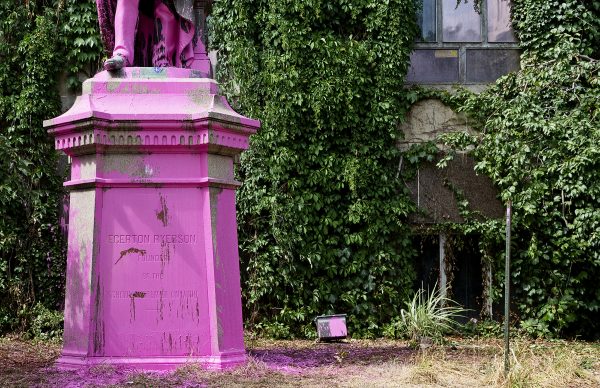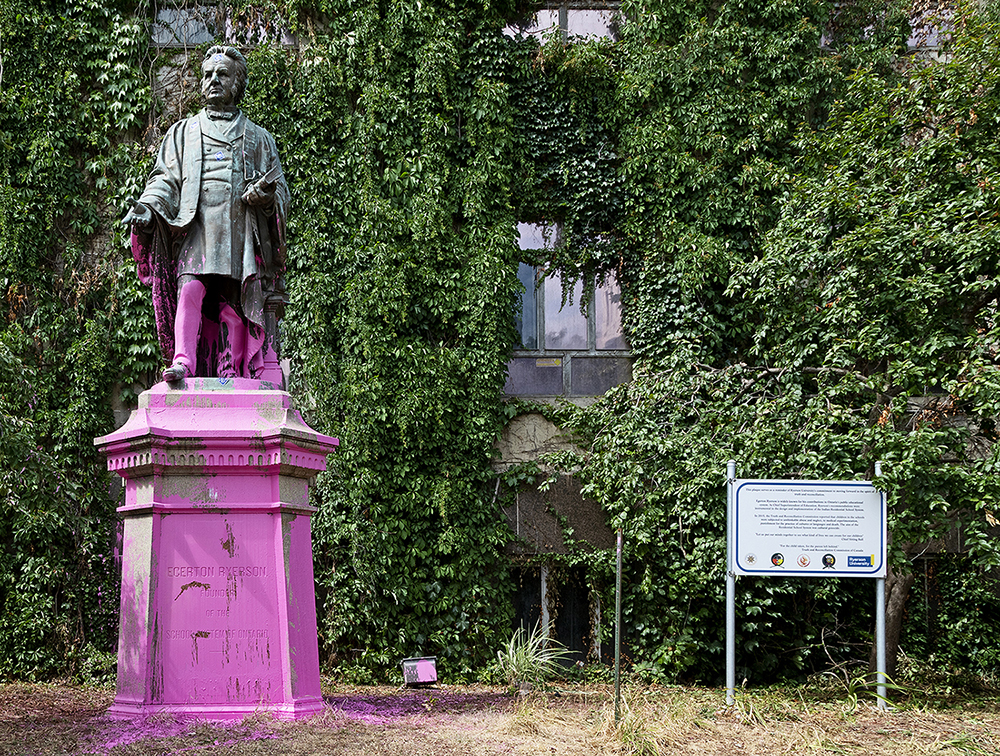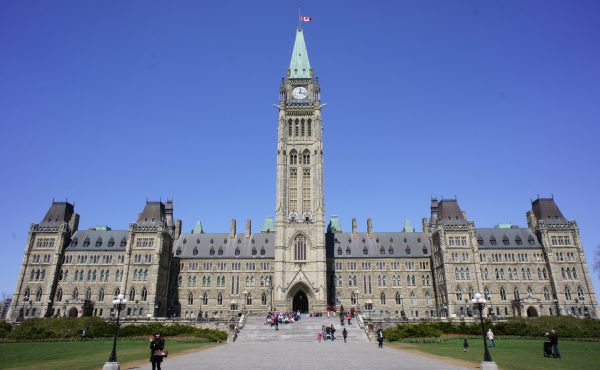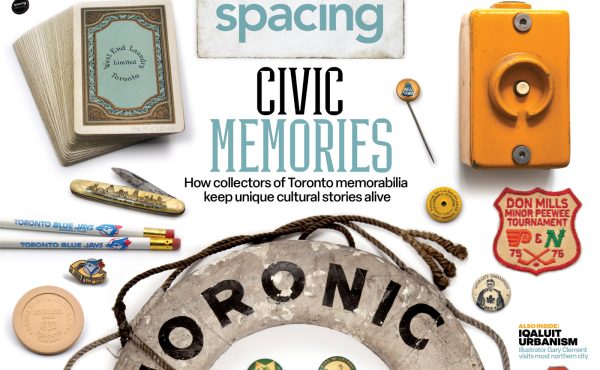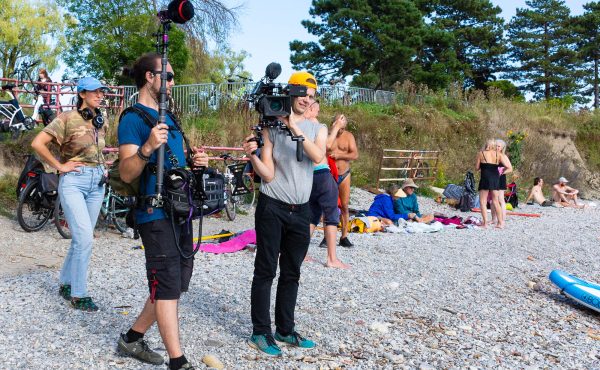This essay is excerpted with permission from Indigenous Toronto: Stories That Carry This Place (Coach House Books, 2021).
NOW THAT WE KNOW
When I first accepted a faculty position at the downtown Tkaronto university where I now work, I was unaware of the legacy of the man whose name the institution bears. I didn’t know the significance of the statue I pass dozens of times each day. I didn’t know that this man, who as Chief Superintendent of Schools for what was then called Upper Canada, advocated free compulsory public day schools for white children only. I didn’t know he had a different vision for Indigenous children – a vision that would pave the way for the Indian residential school system. I didn’t know he enacted the 1850 Common Schools Act, a piece of legislation resulting in the ‘legal’ exclusion of Black children from public schools in Ontario and forcing them to attend segregated schools in communities across the province. I didn’t know he opposed education for girls beyond the elementary level, his opposition grounded in the belief that a woman’s place is in the home. I didn’t know he found ‘hermaphrodite spawn’ a fitting insult to hurl at his enemies, an insult that amplifies the transphobia that settlers brought to the Americas.
In 1847, this man penned a letter that would seal the fate of thousands upon thousands of Indigenous children and their descendants – if they were fortunate enough to survive long enough to have descendants – for years to come. He proposed a method of establishing and conducting industrial schools for the ‘benefit of Indian children’ that were reminiscent of British workhouses. These schools would not ‘contemplate anything more in respect to intellectual training than to give them a plain English education adapted to the working farmer or mechanic.’
They would, he continued, provide training in ‘agriculture, kitchen-gardening and mechanics so far as mechanics is connected with making and repairing the most useful agricultural implements.’
To attain this objective, he argued, it would be necessary for the students to live away from their families, with provision being made for their domestic and religious education. As a devout Christian minister of the Methodist Episcopal Church, he was particularly concerned with religious indoctrination for Indigenous children. He insisted the only way to ‘civilize’ Indigenous children would be to remove them from the influence of their families. In other words, remove them from the influence of their languages, spirituality, ceremonies, culture, and all their relations. He wrote: ‘With him nothing can be done to improve and elevate his character and condition without the aid of religious feeling.’ He stated as fact that the ‘North American Indian cannot be civilized or preserved in a state of civilization except in connection with, if not by the influence of, not only religious instruction and sentiment but of religious feelings.’
Therefore, he reasoned, the running of the schools ‘should be a joint effort of the Government and of the Church.’ Ultimately, the goal was to use education, particularly religious education, to assimilate Indigenous peoples in order to produce industrious farmers. Instruction would be provided only insofar as it contributed to the making of farmers, and nothing more. No time or money would be spent on any other area – only agriculture. He noted that children should be put to work from eight to twelve hours a day during the summer; only two to four of those hours would be for instruction. In the planting and harvesting periods, instruction should be removed altogether. He was detailed in his recommendations, down to prescribing the daily schedule. He would have the children wake up at 5:00 a.m., work all day, and go to bed after prayers at 8:00 or 9:00 p.m.
This letter of 1847 set the stage for the forced removal of Indigenous children from their ‘uncivilized’ homes. It set the stage for the horror of residential schools.
You might argue that this man did not intend for any children to be sexually abused by their teachers. You might argue that he did not intend for children to be starved, that he did not intend for them to be used in experiments. You might argue that he did not intend for them to be ripped from their mothers’ arms. And you would, no doubt, be right.
You might argue that his intentions were good.
I would argue back to you that his ‘good intentions’ paved a road directly to a living hell on Earth from which Indigenous people all across Canada have not yet recovered.
You might argue he was a man of his time and that you cannot judge the past by the standards of the present. My argument back to you is that the only way to judge the past is by the present. My argument back to you is to let history be the judge. In my culture, we are taught that our actions must be guided by the impact they will have for the next seven generations. This man’s actions do not stand the test of time.
So you might excuse me if I cringe as I walk by his statue. Now that I know.
Colleagues tell me that this man was a friend to Indigenous peoples. His best friend, they say, was Peter Jones (Kahkewaquonaby). He even invited Peter into his home to convalesce. Proof, they say, that he was not a racist.
Let’s look a little more closely at this claim. As a child, Peter Jones was raised by his Anishinaabekwe mother in the traditional culture and spiritual beliefs of his people. But when he was fourteen years old, he went to live with his United Empire Loyalist father, from whom he learned the ways and language of the white Christian settlers of Upper Canada. Peter converted to Methodism as a young man and became a preacher, giving the Methodists an inroad into both the Mississaugas of the Credit and the nearby Kanien’kehá:ka communities. He, along with his best friend, was instrumental in leading the conversion of the Mississaugas of the Credit to a European lifestyle of agriculture and Christianity.
It is disingenuous to claim that our institution’s namesake was a friend to all Indigenous people based on his friendship with one Indigenous man who converted to Christianity and essentially became white. That he lived among the Mississaugas of the Credit for a number of years, teaching them how to farm, is also held up as proof of his friendship to Indigenous people. His belief that Indigenous people should adopt the ‘civilized’ values of hard work, as opposed to what he must have considered the ‘uncivilized’ work of hunting and fishing, is further proof, in their minds, that he was a friend. Everything he did for Indigenous people, they say, was for their own good. He wanted them to survive in a rapidly changing industrial society. His heart, they say, was in the right place.
I am left wondering what kind of friend sees no value in his friends. What kind of friend would force his own religion, education, and language on his friends? This man was no friend to Indigenous people – he couldn’t see them. He couldn’t see their generosity and lack of greed. He couldn’t see their sophisticated governance structures. He learned their language but couldn’t hear its beauty, nor understand its knowledge. This man was no friend to Indigenous people because he didn’t love them enough to understand them. Like his god, he only wanted to make them over in his own likeness.
So you might excuse me if I choke on his name each time it passes my lips. Now that I know.
He was a friend of Sir John A. Macdonald, a man who openly held Indigenous people in contempt, calling for their starvation and confinement. This friendship calls into question the good intentions we attribute to our namesake.
My colleagues have yet to come up with a justification for his position on segregated schools for Black children. His own justification resulted in institutionalized racism. He claimed that segregated schools were necessary in some jurisdictions because ‘the prejudices and feelings of the people are stronger than law.’ In the jurisdictions that had segregated schools, Black kids were not allowed to attend white schools. In jurisdictions that had no segregated schools, Black kids had to sit on separate benches. He urged Black taxpayers to sue for the right to attend segregated schools ‘for their own good.’ It is worth noting that the 1850 Common Schools Act would remain on the books for over one hundred years. In post-Confederation Canada, only Ontario and Nova Scotia had legislated school segregation.
Let’s turn for a moment to his position on educating young women. The only thing he had to say about that topic was, don’t do it. They belong in the home. Not only did he oppose the education of women beyond the elementary level, he opposed the participation of girls at grammar schools. He ended co-education at the Upper Canada Academy and insisted on the separation of girls and boys in common schools.7
You might excuse me if I come to the conclusion that this man, for whom the university in downtown Tkaronto where I work is named, laid the groundwork for anti-Indigenous and anti-Black systemic racism. You might excuse me if I ponder the origin of the intersectional pay inequities that still exist to this day at this institution named after a man who was openly racist, sexist, and transphobic. Now that I know.
The thing about knowing is that once you know, you cannot unknow. And so, you might excuse me for questioning the president of the university (as of 2020) for claiming that equity is in our DNA, while at the same time upholding its name. Now that he knows.
In 2017 my dean asked me, as Director of Saagajiwe, to do something to commemorate Canada 150. Saagajiwe is the Indigenous Research Creation Centre within the Faculty of Communication and Design of the university where I work in downtown Tkaronto.
At first, I was stumped. How does one observe 150 years of genocide? I called my friend, and then Saagajiwe artist-in-residence Billy Merasty. We agreed to meet at Glad Day Bookshop on Church Street in Tkaronto to toss around ideas. There, in the backroom with the pink walls, we discussed what we could do to both respect our dean’s request and be true to who we are as Indigenous people. We talked about what Canada means to us. Billy said the only safe place for Indigenous people in Canada is home in community. We thought about what could symbolize home and decided to set up a tipi on campus, but we could not ignore the connection of the university through its name to residential schools.
We decided to bring the children, who died in captivity, home. I spent the next couple of weeks combing through residential school records and archives. Of the more than four thousand names I found, I laser-printed 150 of them (one for each year of confederation) onto cedar planks and hung them inside the tipi. We burned a sacred fire for four days and four nights to honour the children. Each day, twice a day, Billy told stories inside the tipi and Nish Dish brought soup and bannock for the people who gathered there. On the fourth day, we spoke each name aloud and put it on the fire. Nish Dish prepared a feast. The ashes were carried to Lake Ontario. We named our installation Survival through Sovereignty. Its next phase will be a wall made from the four-thousand-plus names built around the statue. To honour each of the children in turn, we will light an eternal flame and put one name up every four days. The wall, which will take four years or so to build, will, once complete, hide the statue.
Perhaps you will accuse me of cancel culture, of wanting to airbrush this man from history, of falling victim to a trend. Rather than erase him, I would like to see him take his rightful place in history. I want to acknowledge the impact his actions had on the children of future generations. I want to tell you how it makes me feel in my mind, spirit, and body to walk through the halls of a place that bears his name and to pass by the statue that bears his likeness.
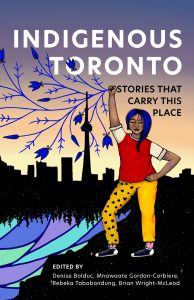 I am not the only one. Many of my Indigenous and Black colleagues will tell you the same. Black and Indigenous students are already telling you how they feel as they rise up and throw red paint on the statue – paint that, to them, symbolizes the blood of the children who went to residential schools. The statue that, to them, symbolizes violence on their bodies. I know of one Annishnaabeg student in the School of Journalism who left the university simply because he could no longer bear to walk by that statue. Once he knew.
I am not the only one. Many of my Indigenous and Black colleagues will tell you the same. Black and Indigenous students are already telling you how they feel as they rise up and throw red paint on the statue – paint that, to them, symbolizes the blood of the children who went to residential schools. The statue that, to them, symbolizes violence on their bodies. I know of one Annishnaabeg student in the School of Journalism who left the university simply because he could no longer bear to walk by that statue. Once he knew.
Now that we know, I want us to choose a different name for this university in downtown Tkaronto. I want us to choose a name that celebrates Indigenous and Black cultures. I want us to choose a name that honours women and trans folk. A name that speaks to diversity and inclusion in all its complexity. A name that reflects the values of the Indigenous peoples of this land before settlers arrived – values that were woke before woke was a thing. I want us to choose a name that will stand the test of time. A name that has the courage to let history be its judge.
Dr. Lila Pine, Mi’gmewi’sgw of mixed ancestry, is bound by the Peace and Friendship Treaty. She divides her time between Mi’gma’gi, where she belongs, and Tkaronto, where she teaches in the RTA School of Media at a downtown university. This essay is excerpted with permission from Indigenous Toronto: Stories That Carry This Place (Coach House Books, 2021). Copies are available at the Spacing Store.

